Quantitative Analysis: UK Structured Kickout Products for Portfolio
VerifiedAdded on 2023/06/08
|14
|4454
|300
Report
AI Summary
This report provides a quantitative analysis of kickout products, specifically focusing on those listed as UK structured products. It begins with an introduction to wealth management and the importance of investment strategies, highlighting the challenges and risks associated with selecting and managing structured products. The research process employs an interpretivism philosophy and an inductive approach, utilizing quantitative research methods to analyze the performance of various kickout products. The findings detail several Societe Generale UK and US Step Down Kick-out Plans, along with products from Walker Crips, Meteor, Morgan Stanley and Investec, evaluating their capital growth, risk indicators, and investment terms. The analysis aims to provide clients with the information needed to make informed investment decisions, considering factors such as capital protection barriers and counterparty risks. Desklib offers access to this assignment and a wealth of other study resources.

Quantitative Analysis of
Kickout Products
Kickout Products
Paraphrase This Document
Need a fresh take? Get an instant paraphrase of this document with our AI Paraphraser
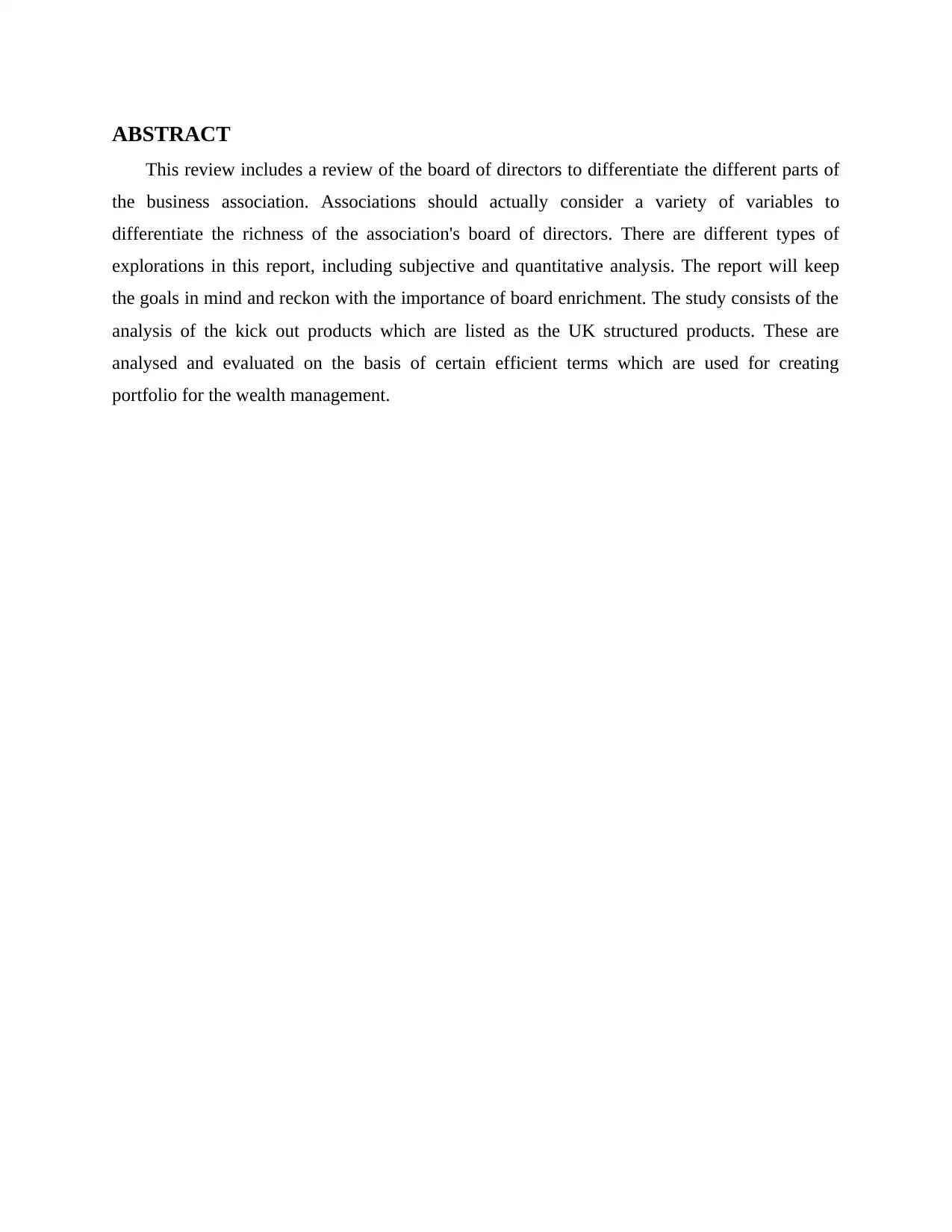
ABSTRACT
This review includes a review of the board of directors to differentiate the different parts of
the business association. Associations should actually consider a variety of variables to
differentiate the richness of the association's board of directors. There are different types of
explorations in this report, including subjective and quantitative analysis. The report will keep
the goals in mind and reckon with the importance of board enrichment. The study consists of the
analysis of the kick out products which are listed as the UK structured products. These are
analysed and evaluated on the basis of certain efficient terms which are used for creating
portfolio for the wealth management.
This review includes a review of the board of directors to differentiate the different parts of
the business association. Associations should actually consider a variety of variables to
differentiate the richness of the association's board of directors. There are different types of
explorations in this report, including subjective and quantitative analysis. The report will keep
the goals in mind and reckon with the importance of board enrichment. The study consists of the
analysis of the kick out products which are listed as the UK structured products. These are
analysed and evaluated on the basis of certain efficient terms which are used for creating
portfolio for the wealth management.
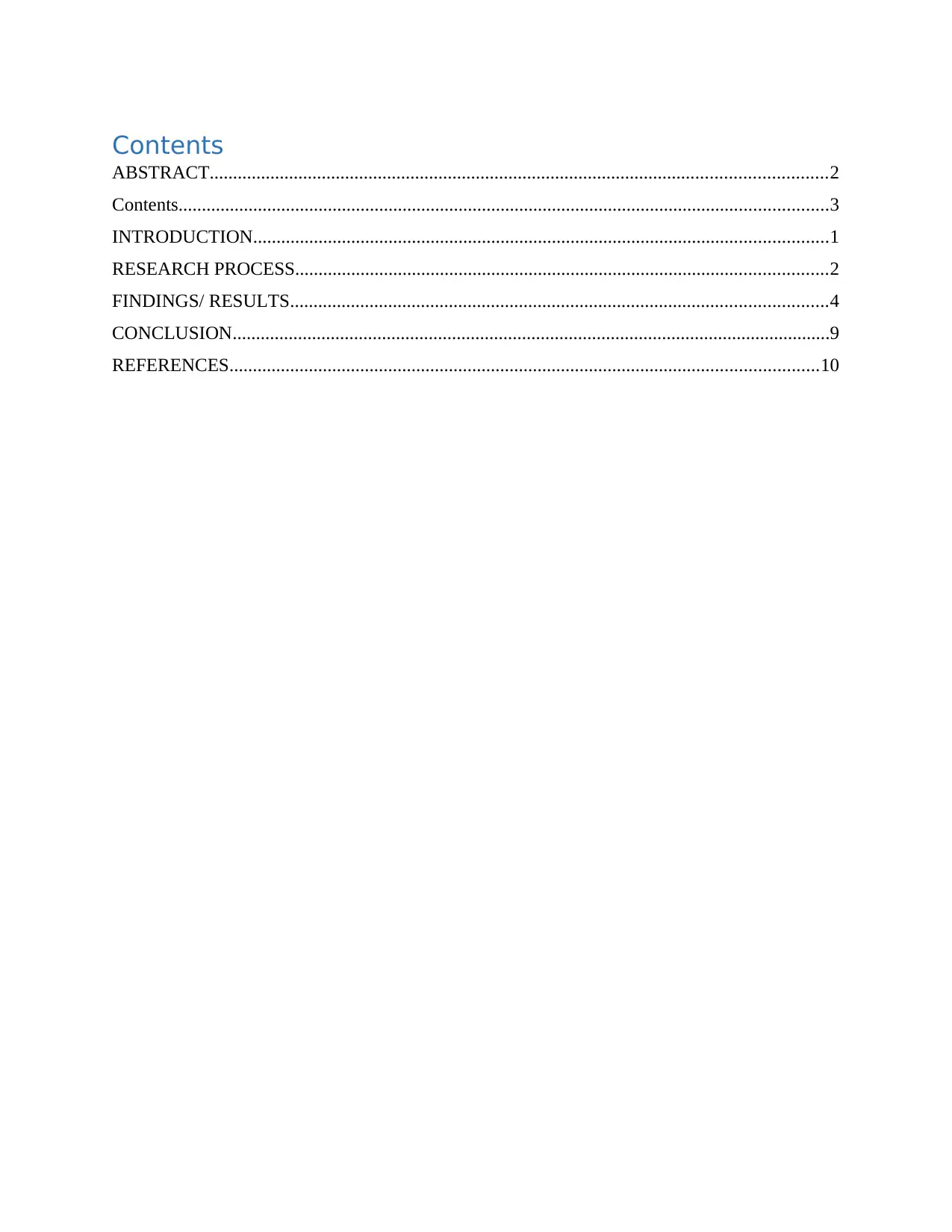
Contents
ABSTRACT....................................................................................................................................2
Contents...........................................................................................................................................3
INTRODUCTION...........................................................................................................................1
RESEARCH PROCESS..................................................................................................................2
FINDINGS/ RESULTS...................................................................................................................4
CONCLUSION................................................................................................................................9
REFERENCES..............................................................................................................................10
ABSTRACT....................................................................................................................................2
Contents...........................................................................................................................................3
INTRODUCTION...........................................................................................................................1
RESEARCH PROCESS..................................................................................................................2
FINDINGS/ RESULTS...................................................................................................................4
CONCLUSION................................................................................................................................9
REFERENCES..............................................................................................................................10
⊘ This is a preview!⊘
Do you want full access?
Subscribe today to unlock all pages.

Trusted by 1+ million students worldwide
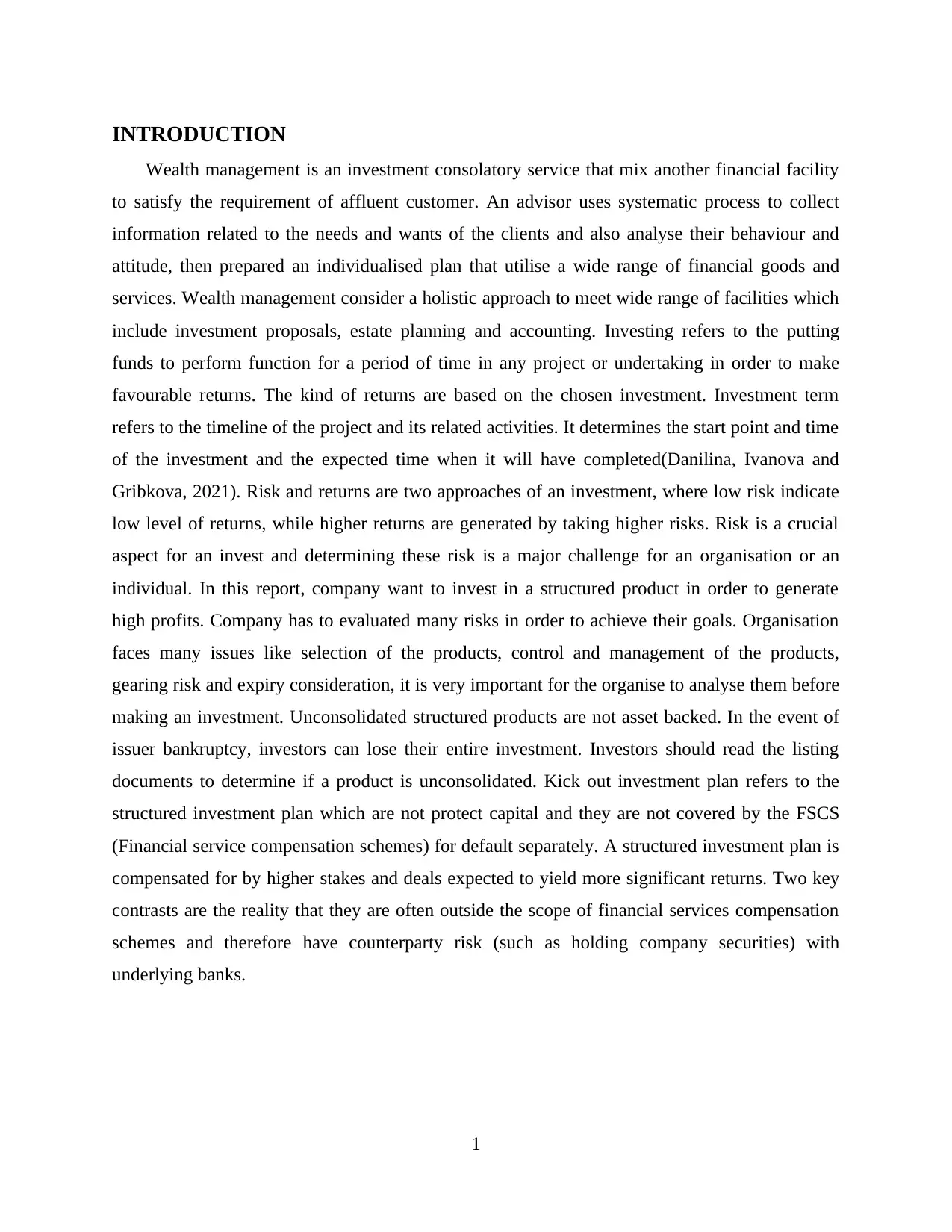
INTRODUCTION
Wealth management is an investment consolatory service that mix another financial facility
to satisfy the requirement of affluent customer. An advisor uses systematic process to collect
information related to the needs and wants of the clients and also analyse their behaviour and
attitude, then prepared an individualised plan that utilise a wide range of financial goods and
services. Wealth management consider a holistic approach to meet wide range of facilities which
include investment proposals, estate planning and accounting. Investing refers to the putting
funds to perform function for a period of time in any project or undertaking in order to make
favourable returns. The kind of returns are based on the chosen investment. Investment term
refers to the timeline of the project and its related activities. It determines the start point and time
of the investment and the expected time when it will have completed(Danilina, Ivanova and
Gribkova, 2021). Risk and returns are two approaches of an investment, where low risk indicate
low level of returns, while higher returns are generated by taking higher risks. Risk is a crucial
aspect for an invest and determining these risk is a major challenge for an organisation or an
individual. In this report, company want to invest in a structured product in order to generate
high profits. Company has to evaluated many risks in order to achieve their goals. Organisation
faces many issues like selection of the products, control and management of the products,
gearing risk and expiry consideration, it is very important for the organise to analyse them before
making an investment. Unconsolidated structured products are not asset backed. In the event of
issuer bankruptcy, investors can lose their entire investment. Investors should read the listing
documents to determine if a product is unconsolidated. Kick out investment plan refers to the
structured investment plan which are not protect capital and they are not covered by the FSCS
(Financial service compensation schemes) for default separately. A structured investment plan is
compensated for by higher stakes and deals expected to yield more significant returns. Two key
contrasts are the reality that they are often outside the scope of financial services compensation
schemes and therefore have counterparty risk (such as holding company securities) with
underlying banks.
1
Wealth management is an investment consolatory service that mix another financial facility
to satisfy the requirement of affluent customer. An advisor uses systematic process to collect
information related to the needs and wants of the clients and also analyse their behaviour and
attitude, then prepared an individualised plan that utilise a wide range of financial goods and
services. Wealth management consider a holistic approach to meet wide range of facilities which
include investment proposals, estate planning and accounting. Investing refers to the putting
funds to perform function for a period of time in any project or undertaking in order to make
favourable returns. The kind of returns are based on the chosen investment. Investment term
refers to the timeline of the project and its related activities. It determines the start point and time
of the investment and the expected time when it will have completed(Danilina, Ivanova and
Gribkova, 2021). Risk and returns are two approaches of an investment, where low risk indicate
low level of returns, while higher returns are generated by taking higher risks. Risk is a crucial
aspect for an invest and determining these risk is a major challenge for an organisation or an
individual. In this report, company want to invest in a structured product in order to generate
high profits. Company has to evaluated many risks in order to achieve their goals. Organisation
faces many issues like selection of the products, control and management of the products,
gearing risk and expiry consideration, it is very important for the organise to analyse them before
making an investment. Unconsolidated structured products are not asset backed. In the event of
issuer bankruptcy, investors can lose their entire investment. Investors should read the listing
documents to determine if a product is unconsolidated. Kick out investment plan refers to the
structured investment plan which are not protect capital and they are not covered by the FSCS
(Financial service compensation schemes) for default separately. A structured investment plan is
compensated for by higher stakes and deals expected to yield more significant returns. Two key
contrasts are the reality that they are often outside the scope of financial services compensation
schemes and therefore have counterparty risk (such as holding company securities) with
underlying banks.
1
Paraphrase This Document
Need a fresh take? Get an instant paraphrase of this document with our AI Paraphraser
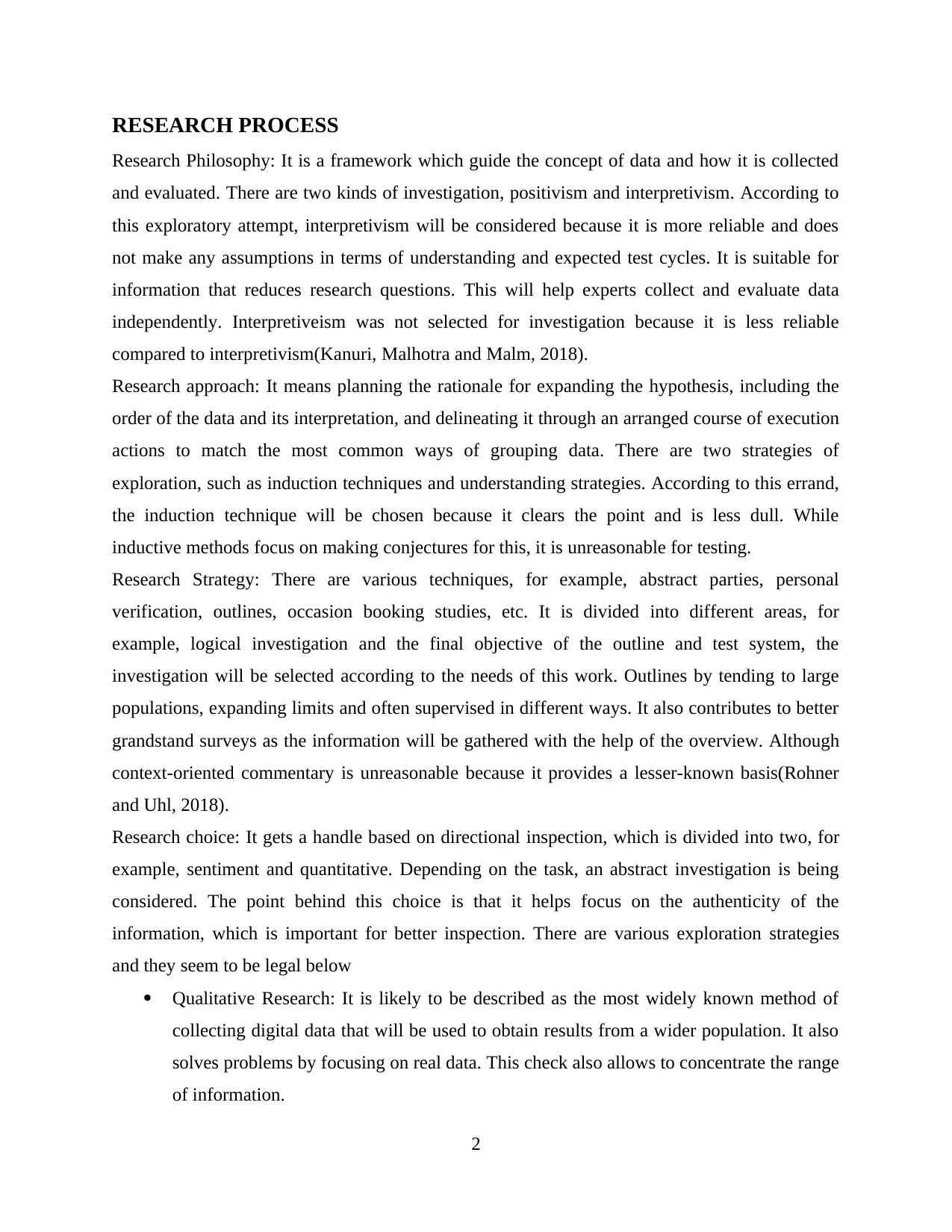
RESEARCH PROCESS
Research Philosophy: It is a framework which guide the concept of data and how it is collected
and evaluated. There are two kinds of investigation, positivism and interpretivism. According to
this exploratory attempt, interpretivism will be considered because it is more reliable and does
not make any assumptions in terms of understanding and expected test cycles. It is suitable for
information that reduces research questions. This will help experts collect and evaluate data
independently. Interpretiveism was not selected for investigation because it is less reliable
compared to interpretivism(Kanuri, Malhotra and Malm, 2018).
Research approach: It means planning the rationale for expanding the hypothesis, including the
order of the data and its interpretation, and delineating it through an arranged course of execution
actions to match the most common ways of grouping data. There are two strategies of
exploration, such as induction techniques and understanding strategies. According to this errand,
the induction technique will be chosen because it clears the point and is less dull. While
inductive methods focus on making conjectures for this, it is unreasonable for testing.
Research Strategy: There are various techniques, for example, abstract parties, personal
verification, outlines, occasion booking studies, etc. It is divided into different areas, for
example, logical investigation and the final objective of the outline and test system, the
investigation will be selected according to the needs of this work. Outlines by tending to large
populations, expanding limits and often supervised in different ways. It also contributes to better
grandstand surveys as the information will be gathered with the help of the overview. Although
context-oriented commentary is unreasonable because it provides a lesser-known basis(Rohner
and Uhl, 2018).
Research choice: It gets a handle based on directional inspection, which is divided into two, for
example, sentiment and quantitative. Depending on the task, an abstract investigation is being
considered. The point behind this choice is that it helps focus on the authenticity of the
information, which is important for better inspection. There are various exploration strategies
and they seem to be legal below
Qualitative Research: It is likely to be described as the most widely known method of
collecting digital data that will be used to obtain results from a wider population. It also
solves problems by focusing on real data. This check also allows to concentrate the range
of information.
2
Research Philosophy: It is a framework which guide the concept of data and how it is collected
and evaluated. There are two kinds of investigation, positivism and interpretivism. According to
this exploratory attempt, interpretivism will be considered because it is more reliable and does
not make any assumptions in terms of understanding and expected test cycles. It is suitable for
information that reduces research questions. This will help experts collect and evaluate data
independently. Interpretiveism was not selected for investigation because it is less reliable
compared to interpretivism(Kanuri, Malhotra and Malm, 2018).
Research approach: It means planning the rationale for expanding the hypothesis, including the
order of the data and its interpretation, and delineating it through an arranged course of execution
actions to match the most common ways of grouping data. There are two strategies of
exploration, such as induction techniques and understanding strategies. According to this errand,
the induction technique will be chosen because it clears the point and is less dull. While
inductive methods focus on making conjectures for this, it is unreasonable for testing.
Research Strategy: There are various techniques, for example, abstract parties, personal
verification, outlines, occasion booking studies, etc. It is divided into different areas, for
example, logical investigation and the final objective of the outline and test system, the
investigation will be selected according to the needs of this work. Outlines by tending to large
populations, expanding limits and often supervised in different ways. It also contributes to better
grandstand surveys as the information will be gathered with the help of the overview. Although
context-oriented commentary is unreasonable because it provides a lesser-known basis(Rohner
and Uhl, 2018).
Research choice: It gets a handle based on directional inspection, which is divided into two, for
example, sentiment and quantitative. Depending on the task, an abstract investigation is being
considered. The point behind this choice is that it helps focus on the authenticity of the
information, which is important for better inspection. There are various exploration strategies
and they seem to be legal below
Qualitative Research: It is likely to be described as the most widely known method of
collecting digital data that will be used to obtain results from a wider population. It also
solves problems by focusing on real data. This check also allows to concentrate the range
of information.
2
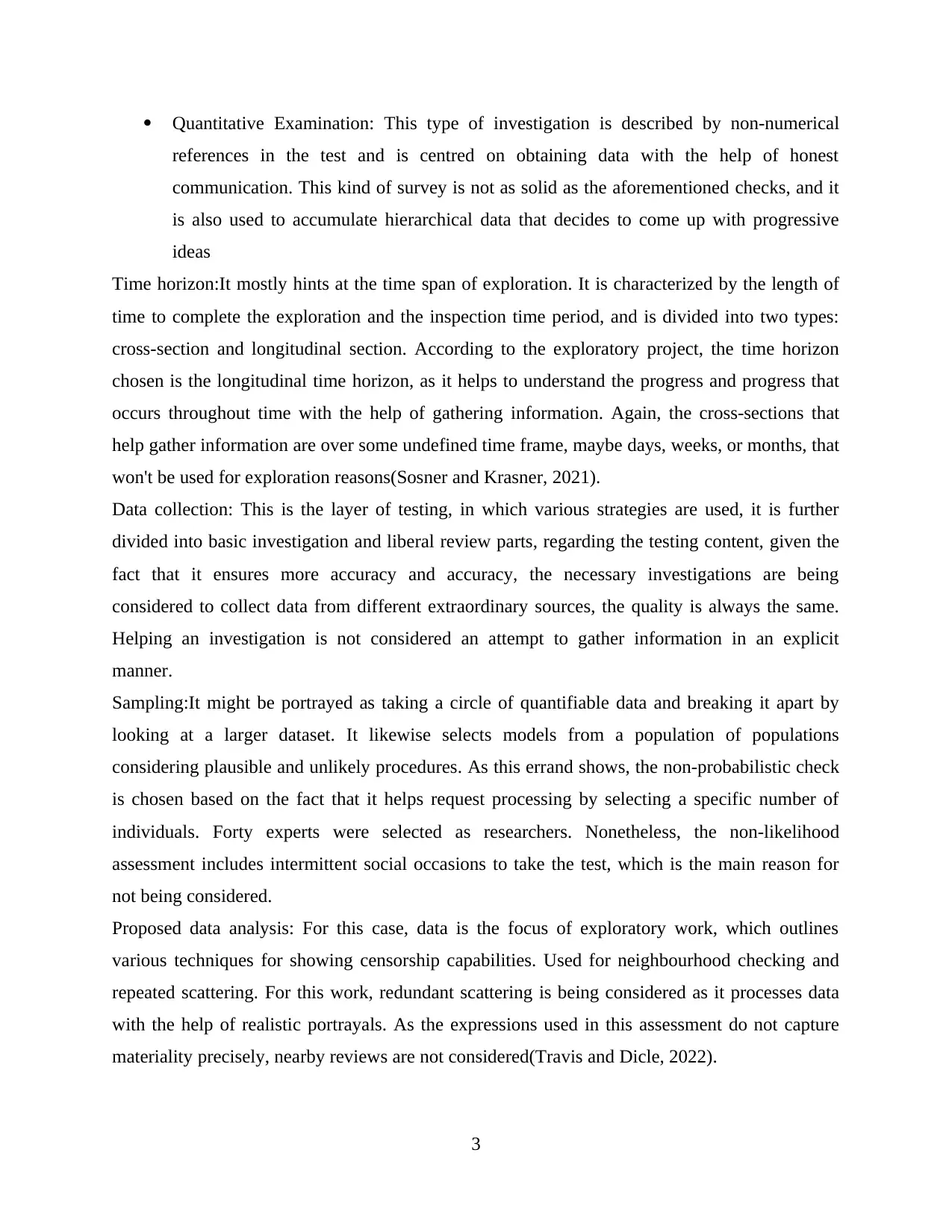
Quantitative Examination: This type of investigation is described by non-numerical
references in the test and is centred on obtaining data with the help of honest
communication. This kind of survey is not as solid as the aforementioned checks, and it
is also used to accumulate hierarchical data that decides to come up with progressive
ideas
Time horizon:It mostly hints at the time span of exploration. It is characterized by the length of
time to complete the exploration and the inspection time period, and is divided into two types:
cross-section and longitudinal section. According to the exploratory project, the time horizon
chosen is the longitudinal time horizon, as it helps to understand the progress and progress that
occurs throughout time with the help of gathering information. Again, the cross-sections that
help gather information are over some undefined time frame, maybe days, weeks, or months, that
won't be used for exploration reasons(Sosner and Krasner, 2021).
Data collection: This is the layer of testing, in which various strategies are used, it is further
divided into basic investigation and liberal review parts, regarding the testing content, given the
fact that it ensures more accuracy and accuracy, the necessary investigations are being
considered to collect data from different extraordinary sources, the quality is always the same.
Helping an investigation is not considered an attempt to gather information in an explicit
manner.
Sampling:It might be portrayed as taking a circle of quantifiable data and breaking it apart by
looking at a larger dataset. It likewise selects models from a population of populations
considering plausible and unlikely procedures. As this errand shows, the non-probabilistic check
is chosen based on the fact that it helps request processing by selecting a specific number of
individuals. Forty experts were selected as researchers. Nonetheless, the non-likelihood
assessment includes intermittent social occasions to take the test, which is the main reason for
not being considered.
Proposed data analysis: For this case, data is the focus of exploratory work, which outlines
various techniques for showing censorship capabilities. Used for neighbourhood checking and
repeated scattering. For this work, redundant scattering is being considered as it processes data
with the help of realistic portrayals. As the expressions used in this assessment do not capture
materiality precisely, nearby reviews are not considered(Travis and Dicle, 2022).
3
references in the test and is centred on obtaining data with the help of honest
communication. This kind of survey is not as solid as the aforementioned checks, and it
is also used to accumulate hierarchical data that decides to come up with progressive
ideas
Time horizon:It mostly hints at the time span of exploration. It is characterized by the length of
time to complete the exploration and the inspection time period, and is divided into two types:
cross-section and longitudinal section. According to the exploratory project, the time horizon
chosen is the longitudinal time horizon, as it helps to understand the progress and progress that
occurs throughout time with the help of gathering information. Again, the cross-sections that
help gather information are over some undefined time frame, maybe days, weeks, or months, that
won't be used for exploration reasons(Sosner and Krasner, 2021).
Data collection: This is the layer of testing, in which various strategies are used, it is further
divided into basic investigation and liberal review parts, regarding the testing content, given the
fact that it ensures more accuracy and accuracy, the necessary investigations are being
considered to collect data from different extraordinary sources, the quality is always the same.
Helping an investigation is not considered an attempt to gather information in an explicit
manner.
Sampling:It might be portrayed as taking a circle of quantifiable data and breaking it apart by
looking at a larger dataset. It likewise selects models from a population of populations
considering plausible and unlikely procedures. As this errand shows, the non-probabilistic check
is chosen based on the fact that it helps request processing by selecting a specific number of
individuals. Forty experts were selected as researchers. Nonetheless, the non-likelihood
assessment includes intermittent social occasions to take the test, which is the main reason for
not being considered.
Proposed data analysis: For this case, data is the focus of exploratory work, which outlines
various techniques for showing censorship capabilities. Used for neighbourhood checking and
repeated scattering. For this work, redundant scattering is being considered as it processes data
with the help of realistic portrayals. As the expressions used in this assessment do not capture
materiality precisely, nearby reviews are not considered(Travis and Dicle, 2022).
3
⊘ This is a preview!⊘
Do you want full access?
Subscribe today to unlock all pages.

Trusted by 1+ million students worldwide
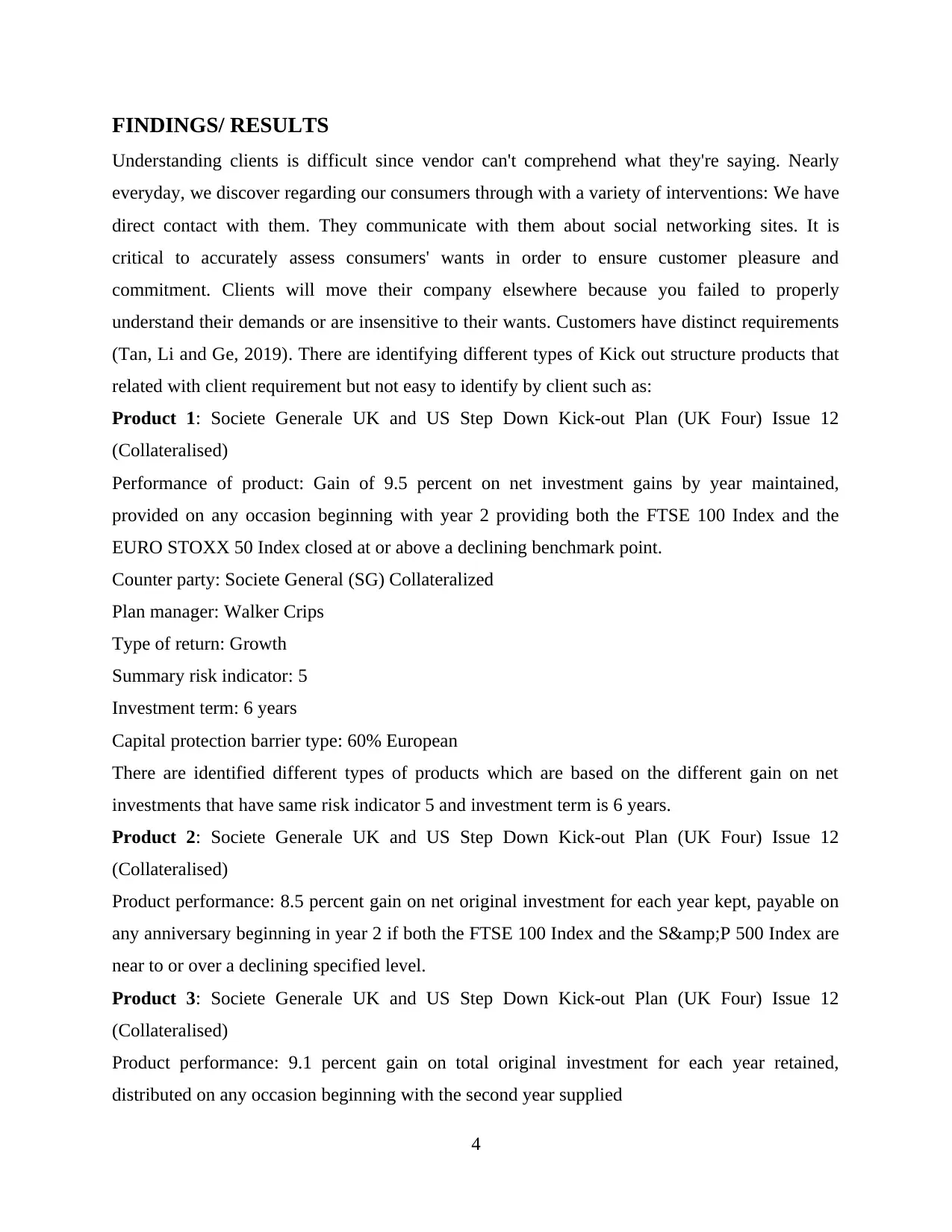
FINDINGS/ RESULTS
Understanding clients is difficult since vendor can't comprehend what they're saying. Nearly
everyday, we discover regarding our consumers through with a variety of interventions: We have
direct contact with them. They communicate with them about social networking sites. It is
critical to accurately assess consumers' wants in order to ensure customer pleasure and
commitment. Clients will move their company elsewhere because you failed to properly
understand their demands or are insensitive to their wants. Customers have distinct requirements
(Tan, Li and Ge, 2019). There are identifying different types of Kick out structure products that
related with client requirement but not easy to identify by client such as:
Product 1: Societe Generale UK and US Step Down Kick-out Plan (UK Four) Issue 12
(Collateralised)
Performance of product: Gain of 9.5 percent on net investment gains by year maintained,
provided on any occasion beginning with year 2 providing both the FTSE 100 Index and the
EURO STOXX 50 Index closed at or above a declining benchmark point.
Counter party: Societe General (SG) Collateralized
Plan manager: Walker Crips
Type of return: Growth
Summary risk indicator: 5
Investment term: 6 years
Capital protection barrier type: 60% European
There are identified different types of products which are based on the different gain on net
investments that have same risk indicator 5 and investment term is 6 years.
Product 2: Societe Generale UK and US Step Down Kick-out Plan (UK Four) Issue 12
(Collateralised)
Product performance: 8.5 percent gain on net original investment for each year kept, payable on
any anniversary beginning in year 2 if both the FTSE 100 Index and the S&P 500 Index are
near to or over a declining specified level.
Product 3: Societe Generale UK and US Step Down Kick-out Plan (UK Four) Issue 12
(Collateralised)
Product performance: 9.1 percent gain on total original investment for each year retained,
distributed on any occasion beginning with the second year supplied
4
Understanding clients is difficult since vendor can't comprehend what they're saying. Nearly
everyday, we discover regarding our consumers through with a variety of interventions: We have
direct contact with them. They communicate with them about social networking sites. It is
critical to accurately assess consumers' wants in order to ensure customer pleasure and
commitment. Clients will move their company elsewhere because you failed to properly
understand their demands or are insensitive to their wants. Customers have distinct requirements
(Tan, Li and Ge, 2019). There are identifying different types of Kick out structure products that
related with client requirement but not easy to identify by client such as:
Product 1: Societe Generale UK and US Step Down Kick-out Plan (UK Four) Issue 12
(Collateralised)
Performance of product: Gain of 9.5 percent on net investment gains by year maintained,
provided on any occasion beginning with year 2 providing both the FTSE 100 Index and the
EURO STOXX 50 Index closed at or above a declining benchmark point.
Counter party: Societe General (SG) Collateralized
Plan manager: Walker Crips
Type of return: Growth
Summary risk indicator: 5
Investment term: 6 years
Capital protection barrier type: 60% European
There are identified different types of products which are based on the different gain on net
investments that have same risk indicator 5 and investment term is 6 years.
Product 2: Societe Generale UK and US Step Down Kick-out Plan (UK Four) Issue 12
(Collateralised)
Product performance: 8.5 percent gain on net original investment for each year kept, payable on
any anniversary beginning in year 2 if both the FTSE 100 Index and the S&P 500 Index are
near to or over a declining specified level.
Product 3: Societe Generale UK and US Step Down Kick-out Plan (UK Four) Issue 12
(Collateralised)
Product performance: 9.1 percent gain on total original investment for each year retained,
distributed on any occasion beginning with the second year supplied
4
Paraphrase This Document
Need a fresh take? Get an instant paraphrase of this document with our AI Paraphraser

Product 4: Societe Generale UK and US Step Down Kick-out Plan (UK Four) Issue 12
(Collateralised)
Product performance: At this product get 6.4% growth on the investment which is lower
compare of other products performance.
From the all above 4 products are same category but all are based on the different capital
investment gain which is presenting their accrual performance and help to client to take right
decision in regard of investment but these are based on the same risk indicator which is 5 and
investment term is 6 year.
Product 5: Walker Crips Defensive annual growth plan issue 13 (Kick out)
Product performance: This product is based on the different category in which get 6.25% capital
growth but in this product has lower risk indicator which is 4 that good for the client and help
them in investment in proper manner. On their 6 years anniversary they are provided 75% of its
initial level. So on the basis of these information client will tale right decision in regard of
investment.
Product 6: Meteor FTSE kick out plan February 2015
Product performance: If the FTSE 100 Index is at or above its starting index level, 9% capital
growth for each year the investment is kept is received on any milestone after year 2.
Counterparty: Santander UK plc
Underlying: FTSE 100 Index
Capital protection barrier type: 50% European
Plan manager: Walker Crips
Product 7: Morgan Stanley dual index defensive kick out plan 7
Product performance: If client want to investment in this product so they are getting 9% capital
growth in 6 years wherever risk indicator in this product is 5.
Counterparty: Morgan Stanley
Underlying: FTSE 100 Index
Capital protection barrier type: 60% European
Plan manager: Meteor Asset Management
On this basis of these description it is saying that it is early kick out product so as per the provide
information can help in regard of investment.
5
(Collateralised)
Product performance: At this product get 6.4% growth on the investment which is lower
compare of other products performance.
From the all above 4 products are same category but all are based on the different capital
investment gain which is presenting their accrual performance and help to client to take right
decision in regard of investment but these are based on the same risk indicator which is 5 and
investment term is 6 year.
Product 5: Walker Crips Defensive annual growth plan issue 13 (Kick out)
Product performance: This product is based on the different category in which get 6.25% capital
growth but in this product has lower risk indicator which is 4 that good for the client and help
them in investment in proper manner. On their 6 years anniversary they are provided 75% of its
initial level. So on the basis of these information client will tale right decision in regard of
investment.
Product 6: Meteor FTSE kick out plan February 2015
Product performance: If the FTSE 100 Index is at or above its starting index level, 9% capital
growth for each year the investment is kept is received on any milestone after year 2.
Counterparty: Santander UK plc
Underlying: FTSE 100 Index
Capital protection barrier type: 50% European
Plan manager: Walker Crips
Product 7: Morgan Stanley dual index defensive kick out plan 7
Product performance: If client want to investment in this product so they are getting 9% capital
growth in 6 years wherever risk indicator in this product is 5.
Counterparty: Morgan Stanley
Underlying: FTSE 100 Index
Capital protection barrier type: 60% European
Plan manager: Meteor Asset Management
On this basis of these description it is saying that it is early kick out product so as per the provide
information can help in regard of investment.
5
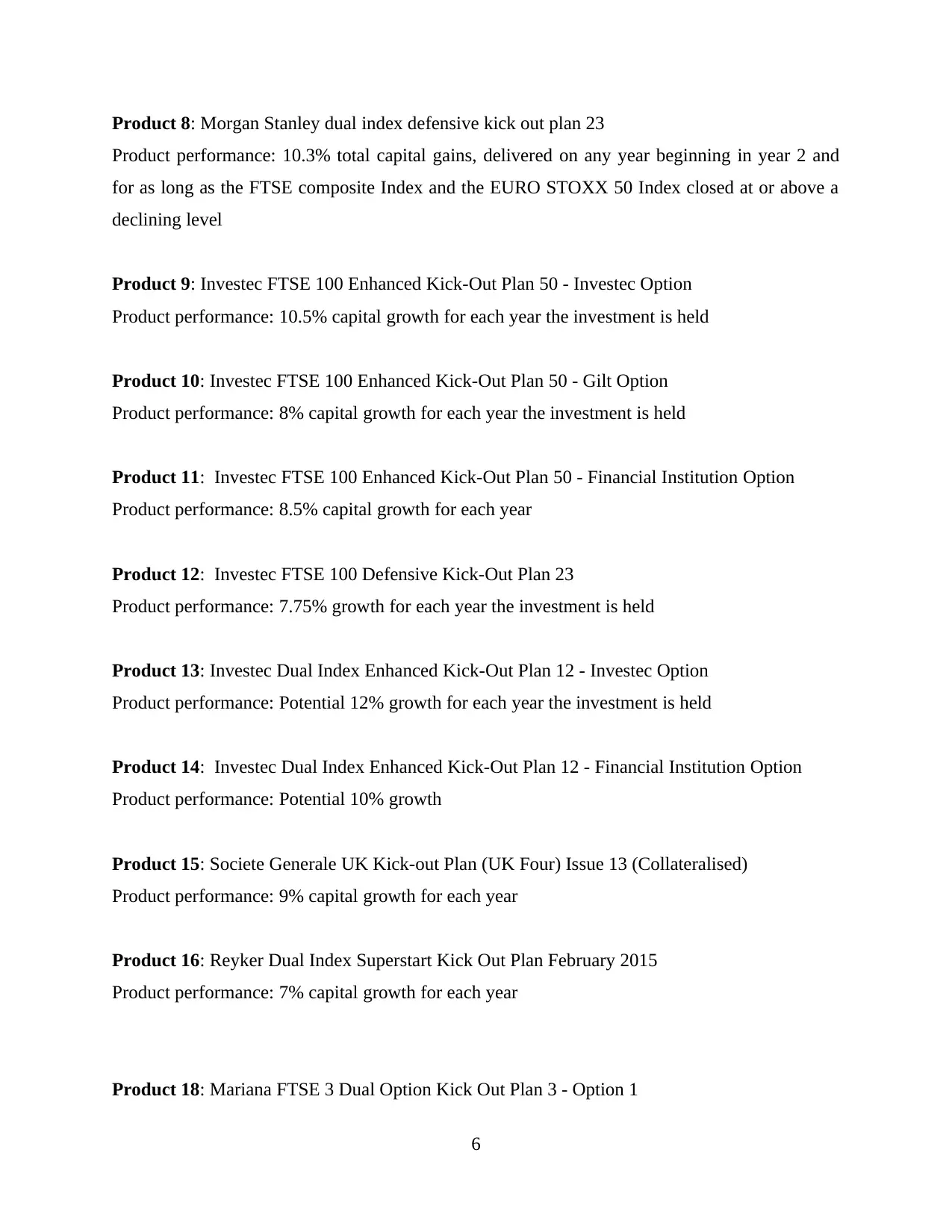
Product 8: Morgan Stanley dual index defensive kick out plan 23
Product performance: 10.3% total capital gains, delivered on any year beginning in year 2 and
for as long as the FTSE composite Index and the EURO STOXX 50 Index closed at or above a
declining level
Product 9: Investec FTSE 100 Enhanced Kick-Out Plan 50 - Investec Option
Product performance: 10.5% capital growth for each year the investment is held
Product 10: Investec FTSE 100 Enhanced Kick-Out Plan 50 - Gilt Option
Product performance: 8% capital growth for each year the investment is held
Product 11: Investec FTSE 100 Enhanced Kick-Out Plan 50 - Financial Institution Option
Product performance: 8.5% capital growth for each year
Product 12: Investec FTSE 100 Defensive Kick-Out Plan 23
Product performance: 7.75% growth for each year the investment is held
Product 13: Investec Dual Index Enhanced Kick-Out Plan 12 - Investec Option
Product performance: Potential 12% growth for each year the investment is held
Product 14: Investec Dual Index Enhanced Kick-Out Plan 12 - Financial Institution Option
Product performance: Potential 10% growth
Product 15: Societe Generale UK Kick-out Plan (UK Four) Issue 13 (Collateralised)
Product performance: 9% capital growth for each year
Product 16: Reyker Dual Index Superstart Kick Out Plan February 2015
Product performance: 7% capital growth for each year
Product 18: Mariana FTSE 3 Dual Option Kick Out Plan 3 - Option 1
6
Product performance: 10.3% total capital gains, delivered on any year beginning in year 2 and
for as long as the FTSE composite Index and the EURO STOXX 50 Index closed at or above a
declining level
Product 9: Investec FTSE 100 Enhanced Kick-Out Plan 50 - Investec Option
Product performance: 10.5% capital growth for each year the investment is held
Product 10: Investec FTSE 100 Enhanced Kick-Out Plan 50 - Gilt Option
Product performance: 8% capital growth for each year the investment is held
Product 11: Investec FTSE 100 Enhanced Kick-Out Plan 50 - Financial Institution Option
Product performance: 8.5% capital growth for each year
Product 12: Investec FTSE 100 Defensive Kick-Out Plan 23
Product performance: 7.75% growth for each year the investment is held
Product 13: Investec Dual Index Enhanced Kick-Out Plan 12 - Investec Option
Product performance: Potential 12% growth for each year the investment is held
Product 14: Investec Dual Index Enhanced Kick-Out Plan 12 - Financial Institution Option
Product performance: Potential 10% growth
Product 15: Societe Generale UK Kick-out Plan (UK Four) Issue 13 (Collateralised)
Product performance: 9% capital growth for each year
Product 16: Reyker Dual Index Superstart Kick Out Plan February 2015
Product performance: 7% capital growth for each year
Product 18: Mariana FTSE 3 Dual Option Kick Out Plan 3 - Option 1
6
⊘ This is a preview!⊘
Do you want full access?
Subscribe today to unlock all pages.

Trusted by 1+ million students worldwide
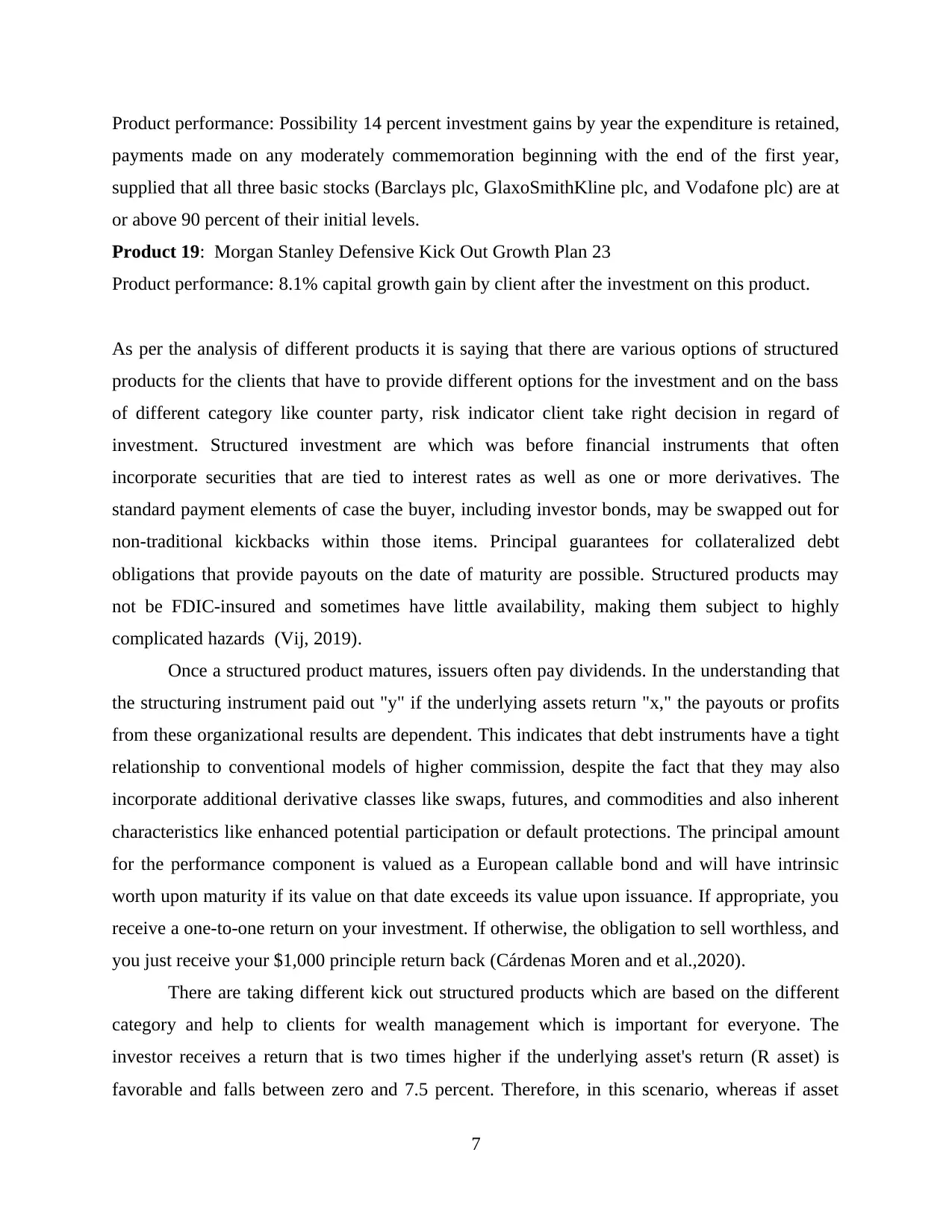
Product performance: Possibility 14 percent investment gains by year the expenditure is retained,
payments made on any moderately commemoration beginning with the end of the first year,
supplied that all three basic stocks (Barclays plc, GlaxoSmithKline plc, and Vodafone plc) are at
or above 90 percent of their initial levels.
Product 19: Morgan Stanley Defensive Kick Out Growth Plan 23
Product performance: 8.1% capital growth gain by client after the investment on this product.
As per the analysis of different products it is saying that there are various options of structured
products for the clients that have to provide different options for the investment and on the bass
of different category like counter party, risk indicator client take right decision in regard of
investment. Structured investment are which was before financial instruments that often
incorporate securities that are tied to interest rates as well as one or more derivatives. The
standard payment elements of case the buyer, including investor bonds, may be swapped out for
non-traditional kickbacks within those items. Principal guarantees for collateralized debt
obligations that provide payouts on the date of maturity are possible. Structured products may
not be FDIC-insured and sometimes have little availability, making them subject to highly
complicated hazards (Vij, 2019).
Once a structured product matures, issuers often pay dividends. In the understanding that
the structuring instrument paid out "y" if the underlying assets return "x," the payouts or profits
from these organizational results are dependent. This indicates that debt instruments have a tight
relationship to conventional models of higher commission, despite the fact that they may also
incorporate additional derivative classes like swaps, futures, and commodities and also inherent
characteristics like enhanced potential participation or default protections. The principal amount
for the performance component is valued as a European callable bond and will have intrinsic
worth upon maturity if its value on that date exceeds its value upon issuance. If appropriate, you
receive a one-to-one return on your investment. If otherwise, the obligation to sell worthless, and
you just receive your $1,000 principle return back (Cárdenas Moren and et al.,2020).
There are taking different kick out structured products which are based on the different
category and help to clients for wealth management which is important for everyone. The
investor receives a return that is two times higher if the underlying asset's return (R asset) is
favorable and falls between zero and 7.5 percent. Therefore, in this scenario, whereas if asset
7
payments made on any moderately commemoration beginning with the end of the first year,
supplied that all three basic stocks (Barclays plc, GlaxoSmithKline plc, and Vodafone plc) are at
or above 90 percent of their initial levels.
Product 19: Morgan Stanley Defensive Kick Out Growth Plan 23
Product performance: 8.1% capital growth gain by client after the investment on this product.
As per the analysis of different products it is saying that there are various options of structured
products for the clients that have to provide different options for the investment and on the bass
of different category like counter party, risk indicator client take right decision in regard of
investment. Structured investment are which was before financial instruments that often
incorporate securities that are tied to interest rates as well as one or more derivatives. The
standard payment elements of case the buyer, including investor bonds, may be swapped out for
non-traditional kickbacks within those items. Principal guarantees for collateralized debt
obligations that provide payouts on the date of maturity are possible. Structured products may
not be FDIC-insured and sometimes have little availability, making them subject to highly
complicated hazards (Vij, 2019).
Once a structured product matures, issuers often pay dividends. In the understanding that
the structuring instrument paid out "y" if the underlying assets return "x," the payouts or profits
from these organizational results are dependent. This indicates that debt instruments have a tight
relationship to conventional models of higher commission, despite the fact that they may also
incorporate additional derivative classes like swaps, futures, and commodities and also inherent
characteristics like enhanced potential participation or default protections. The principal amount
for the performance component is valued as a European callable bond and will have intrinsic
worth upon maturity if its value on that date exceeds its value upon issuance. If appropriate, you
receive a one-to-one return on your investment. If otherwise, the obligation to sell worthless, and
you just receive your $1,000 principle return back (Cárdenas Moren and et al.,2020).
There are taking different kick out structured products which are based on the different
category and help to clients for wealth management which is important for everyone. The
investor receives a return that is two times higher if the underlying asset's return (R asset) is
favorable and falls between zero and 7.5 percent. Therefore, in this scenario, whereas if asset
7
Paraphrase This Document
Need a fresh take? Get an instant paraphrase of this document with our AI Paraphraser

returns 7.5 percent, the buyer invests a 15 percent profit. The investment's return will be
restricted at 15% if R asset is higher than 7.5 percent. There really is no negative leveraged if
somehow the asset's return is bad because the owner shares in the negative equally. There is no
main safeguard in this situation. Three fundamental components—risk identification, risk
analysis, and risk evaluation—make up a good risk assessment, despite the fact that many people
are engaged and there are several variables at play (Chumachenko, and et al., 2020).
The capacity to include a multitude of hypotheses into one transaction is one of the main
draws of credit derivatives for individual investors. An illustration of a structured instrument that
provides exposure to many underlying assets. Another well-liked feature is the lookback service.
In a lookback instrument, the valuation of the underlying asset is dependent on an average of
values across the note's period rather than the asset's ultimate value upon maturity. This might
happen every month or every three months (Mollaoğlu, Bucak and Demirel, 2019).
The financial advisor should evaluate a company's fitness or suitability. When making a
direct suggestion, it is the adviser's duty to determine if a product fits client needs and to make
sure that they are aware of and try to describe the company's dangers before making the
suggestion. Advisors should refrain from recommending products they are unfamiliar with. The
issuer and guarantor of the underlying investment are both Morgan Stanley B.V. The returns
outlined in this booklet are what the Plan is intended to give you. Thier contribution will be used
to trade stocks produced through Morgan Stanley B.V., a member of the Morgan Stanley
corporation, and guaranteed by the parent corporation, in order to fulfill this (Morgan Stanley).
These securities are a sort of corporate bond, which is effectively a debt to Morgan Stanley B.V.
that Morgan Stanley B.V. agrees to return when the bond reaches maturity (Eppelbaum, 2020).
Strong investment quality sponsors, most of whom are huge international financial
organisations like Barclays, Deutsche Bank, or JP Morgan Chase, supply the overwhelming bulk
of structured instruments. However comparable to the risks associated with futures, structuring
assets have the potential to lose principle throughout a financial meltdown. Merchandise may be
covered by the issuer rather than the Federal Deposit Insurance Corporation (FDIC). Investors
risk losing their initial capital if the firm experiences liquidity issues or files for bankruptcy. The
Financial Industry Regulatory Authority (FINRA) advises businesses to think about whether
buyers of these and other fixed deposits should be subject to a screening procedure akin to that
demanded of market participants. Financial instruments known as collateralized debt obligations
8
restricted at 15% if R asset is higher than 7.5 percent. There really is no negative leveraged if
somehow the asset's return is bad because the owner shares in the negative equally. There is no
main safeguard in this situation. Three fundamental components—risk identification, risk
analysis, and risk evaluation—make up a good risk assessment, despite the fact that many people
are engaged and there are several variables at play (Chumachenko, and et al., 2020).
The capacity to include a multitude of hypotheses into one transaction is one of the main
draws of credit derivatives for individual investors. An illustration of a structured instrument that
provides exposure to many underlying assets. Another well-liked feature is the lookback service.
In a lookback instrument, the valuation of the underlying asset is dependent on an average of
values across the note's period rather than the asset's ultimate value upon maturity. This might
happen every month or every three months (Mollaoğlu, Bucak and Demirel, 2019).
The financial advisor should evaluate a company's fitness or suitability. When making a
direct suggestion, it is the adviser's duty to determine if a product fits client needs and to make
sure that they are aware of and try to describe the company's dangers before making the
suggestion. Advisors should refrain from recommending products they are unfamiliar with. The
issuer and guarantor of the underlying investment are both Morgan Stanley B.V. The returns
outlined in this booklet are what the Plan is intended to give you. Thier contribution will be used
to trade stocks produced through Morgan Stanley B.V., a member of the Morgan Stanley
corporation, and guaranteed by the parent corporation, in order to fulfill this (Morgan Stanley).
These securities are a sort of corporate bond, which is effectively a debt to Morgan Stanley B.V.
that Morgan Stanley B.V. agrees to return when the bond reaches maturity (Eppelbaum, 2020).
Strong investment quality sponsors, most of whom are huge international financial
organisations like Barclays, Deutsche Bank, or JP Morgan Chase, supply the overwhelming bulk
of structured instruments. However comparable to the risks associated with futures, structuring
assets have the potential to lose principle throughout a financial meltdown. Merchandise may be
covered by the issuer rather than the Federal Deposit Insurance Corporation (FDIC). Investors
risk losing their initial capital if the firm experiences liquidity issues or files for bankruptcy. The
Financial Industry Regulatory Authority (FINRA) advises businesses to think about whether
buyers of these and other fixed deposits should be subject to a screening procedure akin to that
demanded of market participants. Financial instruments known as collateralized debt obligations
8
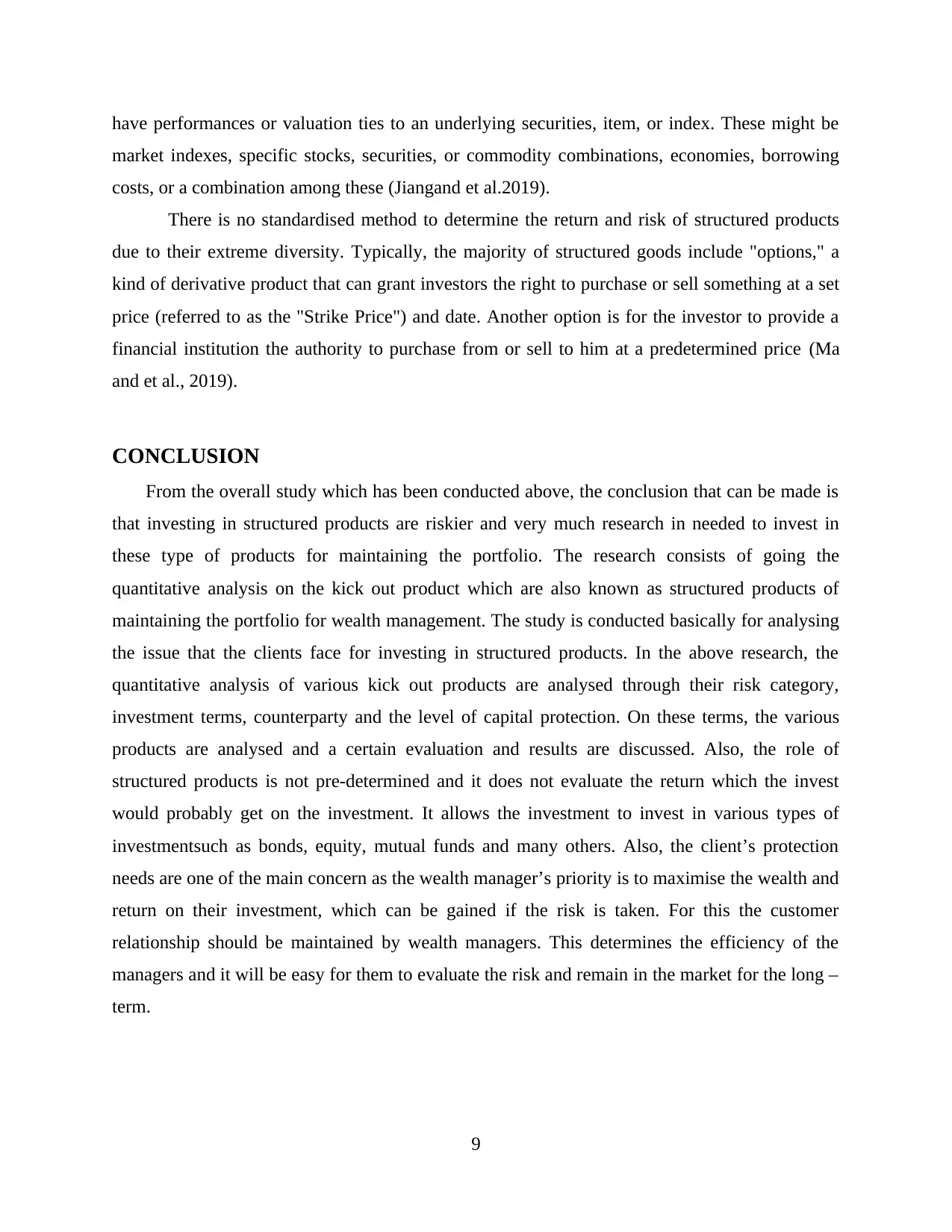
have performances or valuation ties to an underlying securities, item, or index. These might be
market indexes, specific stocks, securities, or commodity combinations, economies, borrowing
costs, or a combination among these (Jiangand et al.2019).
There is no standardised method to determine the return and risk of structured products
due to their extreme diversity. Typically, the majority of structured goods include "options," a
kind of derivative product that can grant investors the right to purchase or sell something at a set
price (referred to as the "Strike Price") and date. Another option is for the investor to provide a
financial institution the authority to purchase from or sell to him at a predetermined price (Ma
and et al., 2019).
CONCLUSION
From the overall study which has been conducted above, the conclusion that can be made is
that investing in structured products are riskier and very much research in needed to invest in
these type of products for maintaining the portfolio. The research consists of going the
quantitative analysis on the kick out product which are also known as structured products of
maintaining the portfolio for wealth management. The study is conducted basically for analysing
the issue that the clients face for investing in structured products. In the above research, the
quantitative analysis of various kick out products are analysed through their risk category,
investment terms, counterparty and the level of capital protection. On these terms, the various
products are analysed and a certain evaluation and results are discussed. Also, the role of
structured products is not pre-determined and it does not evaluate the return which the invest
would probably get on the investment. It allows the investment to invest in various types of
investmentsuch as bonds, equity, mutual funds and many others. Also, the client’s protection
needs are one of the main concern as the wealth manager’s priority is to maximise the wealth and
return on their investment, which can be gained if the risk is taken. For this the customer
relationship should be maintained by wealth managers. This determines the efficiency of the
managers and it will be easy for them to evaluate the risk and remain in the market for the long –
term.
9
market indexes, specific stocks, securities, or commodity combinations, economies, borrowing
costs, or a combination among these (Jiangand et al.2019).
There is no standardised method to determine the return and risk of structured products
due to their extreme diversity. Typically, the majority of structured goods include "options," a
kind of derivative product that can grant investors the right to purchase or sell something at a set
price (referred to as the "Strike Price") and date. Another option is for the investor to provide a
financial institution the authority to purchase from or sell to him at a predetermined price (Ma
and et al., 2019).
CONCLUSION
From the overall study which has been conducted above, the conclusion that can be made is
that investing in structured products are riskier and very much research in needed to invest in
these type of products for maintaining the portfolio. The research consists of going the
quantitative analysis on the kick out product which are also known as structured products of
maintaining the portfolio for wealth management. The study is conducted basically for analysing
the issue that the clients face for investing in structured products. In the above research, the
quantitative analysis of various kick out products are analysed through their risk category,
investment terms, counterparty and the level of capital protection. On these terms, the various
products are analysed and a certain evaluation and results are discussed. Also, the role of
structured products is not pre-determined and it does not evaluate the return which the invest
would probably get on the investment. It allows the investment to invest in various types of
investmentsuch as bonds, equity, mutual funds and many others. Also, the client’s protection
needs are one of the main concern as the wealth manager’s priority is to maximise the wealth and
return on their investment, which can be gained if the risk is taken. For this the customer
relationship should be maintained by wealth managers. This determines the efficiency of the
managers and it will be easy for them to evaluate the risk and remain in the market for the long –
term.
9
⊘ This is a preview!⊘
Do you want full access?
Subscribe today to unlock all pages.

Trusted by 1+ million students worldwide
1 out of 14
Related Documents
Your All-in-One AI-Powered Toolkit for Academic Success.
+13062052269
info@desklib.com
Available 24*7 on WhatsApp / Email
![[object Object]](/_next/static/media/star-bottom.7253800d.svg)
Unlock your academic potential
Copyright © 2020–2025 A2Z Services. All Rights Reserved. Developed and managed by ZUCOL.





